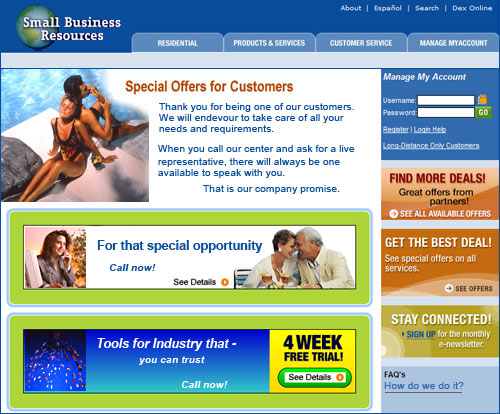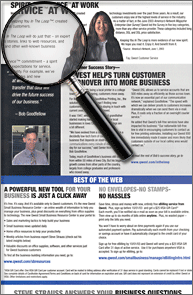The IAB's standard banner sizes range from 486 x 60
to 88 x 31.
Most web sites have their
own limits on memory size,
defined in Ks, since banner ads add to
the total file size
of
the page and increase the time it takes for a browser
to load that page.
Actual graphic content, or creative, varies considerably
among banner ads. The simplest
banner ads feature only
one, static GIF or JPEG image, which is linked to the
advertiser's
home page. More common is the
GIF-animated
banner ad, which displays several different
images in
succession, sometimes to create the effect of
animated
motion. Then there are
rich
media banner ads
-- ads that
use audio, video, or Java and Shockwave
programming. These
banner ads, which usually have
larger file sizes,
are often interactive beyond their
simple
linking function.
Dedicated eMail: SBR features a special trio of dedicated emails
(featured emails only
on your company), followed by small business (SB) enewsletter ads,
and rotating banner
ads to ensure maximum conversions of your products and services to
sales.
Our dedicated enewsletters, which only feature your company, are emailed directly
to small businesses and consumers who have said they want to hear about products
and services like yours. Our dedicated enewsletters are sent to these small business and
consumer enewsletter subscribers and they are then reminded several days later by an
ad in the regularly subscribed SB enewsletter along with rotating banner ads on the website
affiliated with the enewsletter. We often will assist you with the creative for your dedicated
enewsletter, follow up SB enewsletter ad, or banner ad.
Banner Ad Objectives: Ideally, a visitor to the publisher site, the Web site that posts the
banner ad, will click on the banner ad and go to the advertiser's Web site. The banner ad
has brought the advertiser a visitor they would not have had otherwise. The banner ad is
a real success if the visitor not only comes to the site but also buys something. Failing a
click-through, advertisers hope that a publisher site visitor will see the banner ad and will
somehow register it in their heads.

This second effect of advertising is known as branding. If you don't have any other
reason to choose one type of, let's say potato chips, you'll probably choose the
one you're mostfamiliar with, Brand X, even if you're only familiar with it because
of advertising.
Here are several ways advertisers measure banner ad success:
- Clicks/Click-throughs: The number of visitors who click on the banner ad linking
to
the advertiser's Web site. Publisher sites often sell banner ad space on a
cost-per-click (CPC) basis.
- Page views: Also called page impressions, this is the number of times a particular
Web page has been requested from the server. Advertisers are interested in page
views because they indicate the number of visitors who could have seen the
banner ad. The most common way to sell banner ad space is cost per thousand
impressions, or CPM (In roman numerals, M equals a thousand).
- Click-through rate (CTR): This describes the ratio of page views to clicks. It is
expressed as the percentage of total visitors to a particular page who actually
clicked on the banner ad. The typical click-through-rate is under 1 percent.
- Cost per sale: This is the measure of how much advertising money is spent on
making one sale.
- Targeting: As we discussed in a related article on our site on Search Marketing,
advertisers can buy keyword advertising on a search engine, such as Yahoo,
so that their ads are displayed when someone performs a particular search.
If an advertiser buys up keywords related to its product or service, it can probably
increase click-through rates, because the visitor has already demonstrated an
interest in finding sites on that particular subject.
The Internet is an attractive medium to advertisers, because cookies allow sites to gather
information about each visitor. Cookie is a piece of text that a web server can store on
a user's hard disk. Cookies allow a Web site to store information on a user's machine
and later retrieve it.
Effective Banner Ads:
Here are qualities that make for more effective banner ads:
- Post banner ads on pages with related Web content -- the more related, the better.
- Advertise a particular product or service in your banner, rather than your site
generally.
- If you do advertise a particular product or service, link the banner ad to that part
of your Web site, rather than your home page.
- Put banner ads at the top of the page, rather than farther down.
- Use simple messages rather than complicated ones.
- Use animated ads rather than static ones.
- Your graphic content should pique visitor curiosity, without being too obscure.
- Keep banner ad size small. If the page takes too long to load, a lot of visitors
will go on to another page.
Should You Do All Three:
Dedicated Enewsletters/Emailings;
Follow up
Enewsletter Ads; and Banner Ads?
 |
SBR believes that in order for banner ads to
work, they
need to provide enough information
on the solutions that
are being offered:
benefits, problems/solutions; details,
etc so that the
customer can cash in. We like to
have many
reminders in front of the potential customer.
Banner ads are just one part
of the campaign. They help
reinforce the dedicated enewsletter
and follow up ad in
the
subscribed SB enewsletter.
With SBR's emarketing program, Banner Ads, Follow up
Enewsletter Ads, and Dedicated
Mailings all have there
own role for marketing.
Dedicated Mailings are the strongest marketing tool for
direct response, lead generation.
They relay marketing message completely and since the
subscriber has enough information
on a product or service
to take the next step, buy , download, or call, they usually
generate
very qualified clicks. They outperform
enewsletter ads three times or more in response.
|
Follow up ads in enewsletters also accomplish traditional marketing values like banner ads
(hitting a target group more than once). Follow up ads reinforce the marketing message
relayed in the dedicated enewsletter/emailing . It goes after the fence sitters and serves
as a reminder of the previous dedicated enewsletter/emailing.
Banner ads are for building rapport and brand awareness.
Banner ads usually perform the lowest in direct response but their main purpose is not for
direct response. They are important because they create another touch to the marketplace.
Before and after the dedicated enewsletters are launched, the banner ads will work to
reinforce the message so that the recipient of the dedicated emailing will feel familiar with
your company and brand and more receptive of your message.
Over time banner ads, like other forms of media, television, radio, and magazines,
will provide good ole' branding and pay off.
*How Banner Ads Work; www.howstuffworks.com
|





